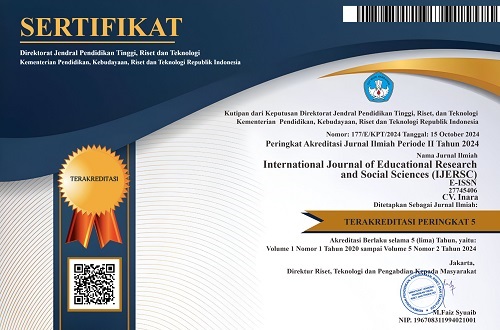Implementation Of The Project-Based Learning (PJBL) Model In The Dance And Drama Arts Education Course To Develop Student Creativity
DOI:
https://doi.org/10.51601/ijersc.v5i4.862Abstract
This study aims to apply the Project Based Learning (PjBL) learning model to dance and drama education in the Elementary School Teacher Education Study Program, FIPP-Yogyakarta State University through art performances in developing student creativity for one semester. Project Based Learning (PjBL) is a learning model that centers on students using projects or activities as a means of learning to gain learning experiences, achieve attitude, knowledge and skill competencies. This research is a type of qualitative research with a descriptive method approach. The researcher conducted a study of dance and drama learning through the performing arts process in developing student creativity in the dance and drama education course. The subjects of the study were all fourth semester students at Yogyakarta State University who took the dance and drama education course in the 2023/2024 Academic Year. The results of this study show that the creativity of dance and drama works in art performances is very good, able to show good creativity, able to apply the project-based learning model, good teamwork and creativity, more independent, able to create new things and productive in managing performing arts management in the dance and drama process. The implementation of the project-based learning model was declared successful and a success in the dance and drama arts education course.
Downloads
References
Ahmad, M. F., Sampurno, M. B. T., Ismail, M., Ali, A. W., & Hashim, N. S. N. (2023). The Impact of Interactive Acting Learning as an Alternative to Digital Acting Teaching in Malaysian Art School: A Comprehensive Review. Journal of Advanced Research in Applied Sciences and Engineering Technology, 33(2), 313–327. https://doi.org/10.37934/ARASET.33.2.313327
Akareem, H. S., & Hossain, S. S. (2016). Determinants of education quality: what makes students’ perception different? Open Review of Educational Research, 3(1), 52–67. https://doi.org/10.1080/23265507.2016.1155167
Alwi, M., Nurfadilah, K., & Hilman, C. (2022). Pendidikan Luar Sekolah dalam Kerangka Pendidikan Sepanjang Hayat. Jurnal Inovasi, Evaluasi, Dan Pengembangan Pembelajaran (JIEPP), 2(2), 90–95. http://journal.ainarapress.org/index.php/jiepp
Delisle, Robert. (1997). How to use problem-based learning in the classroom. Association for Supervision and Curriculum Development.
Dwiyama, F. (2021). Pemasaran Pendidikan Menuju Era Revolusi Industri 5.0. Adaara: Jurnal Manajemen Pendidikan Islam, 11(1), 24–34. https://doi.org/10.35673/AJMPI.V11I1.2117
Harymawan, R. M. A., & Surjaman, T. (1988). Dramaturgi (edisi ke 2). Rosda. https://opac.perpusnas.go.id/DetailOpac.aspx?id=443126
Irvy, I. I. (2020). Understanding the Learning Models Design for Indonesian Teacher. International Journal of Asian Education, 1(2), 95–106. https://doi.org/10.46966/ijae.v1i2.40
Ismed, A. (2005). Seni Peran. Kelir. //opac.isi.ac.id%2Findex.php%3Fp%3Dshow_ detail%26id%3D4528
Jaeni, J. (2023). Arts Communication Model: The Development of Performing Arts through Empowering Cultural Art-Based Tourism. Harmonia: Journal of Arts Research and Education, 23(2), 318–332. https://doi.org/10.15294/harmonia.v23i2.41463
Margono, H., Tri, N. A., & Putri, A. (2023). The Role of Teacher-Librarian in Building Lifelong Learning for Students. Literatify : Trends in Library Developments, 233, 233–243. https://doi.org/10.24252/LITERATIFY.VI.42724
Mursalim. (2008). 15-Membangun Interkoneksi antara Pendidikan Formal Non-Formal dan Informal. Https://Www.Researchgate.Net/Publication/334884207_15-Membangun_ Interkoneksi_antara_Pendidikan_Formal_Non-Formal_dan_Informal.
Nabaho, L., Aguti, J. N., & Oonyu, J. (2019). Unravelling Quality in Higher Education: What Say the Students? Africa Education Review, 16(5), 102–119. https://doi.org/10.1080/18146627.2016.1224600
Pakpahan, A. F., Prasetio, A., Negara, E. S., Gurning, K., Situmorang, R. F. R., Tasnim, Sipayung, P. D., Sesilia, A. P., Rahayu, P. P., Purba, B., Chaeru;, M., Yuniwati, I., Siagian, V., & Rantung, G. A. J. (2021). Metodologi Penelitian Ilmiah. Kita Menulis.
Pendidikan Transformatif, J., Santoso, G., Abdulkarim, A., Maftuh, B., & Murod, mun. (2023). Kajian keikutsertaan Indonesia dalam Organisasi Internasional untuk Perdamaian Dunia di Abad 21. Jurnal Pendidikan Transformatif, 2(1), 157–170. https://doi.org/10.9000/JUPETRA.V2I1.147
Rengganis, A., Haruna, N. H., Sari, A. C., Sitopu, J. H., Brata, D. P. N., Gurning, K., Hasibuan, F. A., Chamidah, D., Kurwanto, Muharlisiani, L. T., Martha, K., & Surbakti, H. (2022). Penelitian dan Pengembangan. Yayasan Kita Menulis.
Rusman. (2018). Model-model Pembelajaran (Edisi kedua). Rajagrafindo Persada. https://www.rajagrafindo.co.id/produk/model-model-pembelajaran/
Santoso, G. (2021). Model Analysis (SWOT) Of Curriculum Development from Civic Education At 21 Century, 4.0 Era In Indonesian. IJEBD (International Journal of Entrepreneurship and Business Development), 4(2), 250–256. https://doi.org/10.29138/IJEBD.V4I2.1221
Sari, R. T., & Jusar, I. R. (2017). Analisis Kebutuhan Modul Pembelajaran Ipa Berorientasi Pendidikan Karakter Melalui Pendekatan Quantum Learning Di Sekolah Dasar. BIOEDUKASI: Jurnal Pendidikan Biologi, 8(1), 26–32. https://doi.org/10.24127/BIOEDUKASI.V8I1.833
Shintawati, D., & Komalasari, H. (2023). Dance Learning Planning with Model Project-Based Learning on the Independent Curriculum at SMAN 1 Cisarua. JDDES: Journal of Dance and Dance Education Studies, 3(2), 59–69. https://ejournal.upi.edu/index.php/.
Downloads
Published
How to Cite
Issue
Section
License
Copyright (c) 2024 International Journal of Educational Research & Social Sciences

This work is licensed under a Creative Commons Attribution 4.0 International License.






















